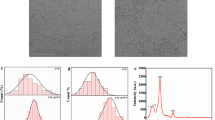Abstract
Nonwoven fibers of cellulose were obtained by electrospinning of cellulose in an ionic liquid, 1-butyl-3-methylinmidazolium chloride (BMIMCl), which is known to be one of the non-volatile solvents. The electrospinning setup was modified in such a way that the syringe was contained in a constant-temperature chamber because of the high melting point of BMIMCl, and the electrospun fibers were collected on the water, which immediately removed the remnant solvent from the electrospun cellulose fibers. The effect of the viscosity of the cellulose solution in BMIMCl on the size and the structure of the fibers was investigated. The crystalline structure of cellulose was examined by X-ray diffraction. Also, the effect of dimethyl sulfoxide, which was expected to induce swelling of cellulose, was studied. The minimum diameter of the continuous electrospun cellulose fibers obtained in this work ranged between 500 and 800 nm.






Similar content being viewed by others
References
Biganska O, Navard P, Bédué O (2002) Crystallisation of cellulose/N-methylmorpholine-N-oxide hydrate solutions. Polymer 43:6139–6145
Cai J, Zhang LN (2005) Rapid dissolution of cellulose in LiOH/urea and NaOH/urea aqueous solutions. Macromol Biosci 5:539–548
Chen XM, Burger C, Fang DF, Ruan D, Zhang LN, Hsiao BS, Chu B (2006) X-ray studies of regenerated cellulose fibers wet spun from cotton linter pulp in NaOH/thiourea aqueous solutions. Polymer 47:2839–2848
Cuissinat C, Navard P, Heinze T (2008) Swelling and dissolution of cellulose. Part IV: Free floating cotton and wood fibres in ionic liquids. Carbohydr Polym 72:590–596
Filho GR, Assunção RMND, Vieira JG, Meireles CDS, Cerqueira DA, Barud HDS, JL Ribeiro S, Messaddeq Y (2007) Characterization of methylcellulose produced from sugar cane bagasse cellulose: crystallinity and thermal properties. Polym Degrad Stab 92:205–210
Frenot A, Henriksson MW, Walkenström P (2007) Electrospinning of cellulose-based nanofibers. J Appl Polym Sci 103:1473–1482
Gutowski KE, Broker GA, Willauer HD, Huddleston JG, Swatloski RP, Holbrey JD, Rogers RD (2003) Controlling the aqueous miscibility of ionic liquids: aqueous biphasic systems of water-miscible ionic liquids and water-structuring salts for recycle, metathesis, and separations. J Am Chem Soc 125:6632–6633
Huang ZM, Zhang YZ, Kotaki M, Ramakrishna S (2003) A review on polymer nanofibers by electrospinning and their applications in nanocomposites. Compos Sci Technol 63:2223–2253
Isogai A, Ishizu A, Nakano J (1986) Dissolution mechanism of cellulose in SO2-amine-dimethylsulfoxide. J Appl Polym Sci 33:1283–1290
Kim CW, Kim DS, Kang SY, Marquez M, Joo YL (2006) Structural studies of electrospun cellulose nanofibers. Polymer 47:5097–5107
McCormick CL, Callais PA Jr, Hutchinson BH (1985) Solution studies of cellulose in lithium chloride and N,N-dimethylacetamide. Macromolecules 18:2394–2401
Rosenau T, Potthast A, Adorjan I, Hofinger A, Sixta H, Firgo H, Kosma P (2002) Cellulose solution in N-methylmorpholine-N-oxide (NMMO)-degradation processes and stabilizers. Cellulose 9:283–291
Sammons RJ, Collier JR, Rials TG, Petrovan S (2008) Rheology of 1-butyl-3-methylimidazolium chloride cellulose solutions. I. Shear rheology. J Appl Polym Sci 110:1175–1181
Son WK, Youk JH, Lee TS, Park WH (2004) Electrospinning of ultrafine cellulose acetate fibers: studies of a new solvent system and deacetylation of ultrafine cellulose acetate fibers. J Polym Sci B Polym Phys 42:5–11
Swatloski RP, Spear SK, Holbrey JD, Rogers RD (2002) Dissolution of cellulose with ionic liquids. J Am Chem Soc 124:4974–4975
Szcześniak L, Rachocki A, Tritt-Goc J (2008) Glass transition temperature and thermal decomposition of cellulose powder. Cellulose 15:445–451
Tsioptsia C, Panayiotou C (2008) Preparation of cellulose-nanohydroxyapatite composite scaffolds from ionic liquid solutions. Carbohydr Polym 74:99–105
Viswanathan G, Murugesan S, Pushparaj V, Nalamasu O, Ajayan PM, Linhard RJ (2006) Preparation of biopolymer fibers by electrospinning from room temperature ionic liquids. Biomacromolecules 7:415–418
Xu S, Zhang J, He A, Li J, Zhang H, Han CC (2008) Electrospinning of native cellulose from nonvolatile solvent system. Polymer 49:2911–2917
Young RA, Rowell RM (1986) Cellulose-structure modification and hydrolysis. Wiley-Interscience, New York
Zhang H, Wu J, Zhang J, He J (2005) 1-Allyl-3-methylimidazolium chloride room temperature ionic liquid: a new and powerful nonderivatizing solvent for cellulose. Macromolecules 38:8272–8277
Zhu SD, Wu YX, Chen QM, Yu ZN, Wang CW, Jin SW, Ding YG, Wu G (2006) Dissolution of cellulose with ionic liquids and its application: a mini-review. Green Chem 8:325–327
Acknowledgments
This work was supported by Inha University Research Grant.
Author information
Authors and Affiliations
Corresponding author
Rights and permissions
About this article
Cite this article
Quan, SL., Kang, SG. & Chin, IJ. Characterization of cellulose fibers electrospun using ionic liquid. Cellulose 17, 223–230 (2010). https://doi.org/10.1007/s10570-009-9386-x
Received:
Accepted:
Published:
Issue Date:
DOI: https://doi.org/10.1007/s10570-009-9386-x




